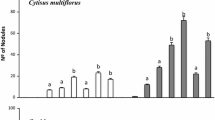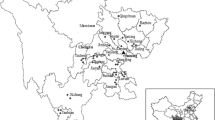Abstract
Selected symbiotic characteristics of fiveBradyrhizobium japonicum strains were assessed in association with ‘Ransom’ soybean plants (Glycine max [L.] Merr.). In the first of two greenhouse experiments, relative nodulation competitiveness of the strains was examined. Strains were grouped into pairs, and corresponding cells were applied to surface-disinfected seeds so as to provide seven ratios of cell numbers between the two strains. Tap root nodules were harvested 28 days after sowing and serotyped by means of an enzyme-linked immunosorbent assay. Strains differed considerably in nodulation competitiveness, and these differences were successfully quantified using relationships previously proposed in the literature. A second experiment involved assessment of the reproducibility of this technique and characterization of the symbiotic response to single- and double-strain inocula. Differences in relative nodulating abilities of strains were apparent between experiments and were possibly related to observed variations in greenhouse temperatures. Plant shoot weight and total N content were not significantly correlated with nodule number or weight when evaluated across inoculation treatments, but these correlations were often significant within inoculation treatments. Certain double-strain inocula produced either positive or negative effects on shoot weight, N content, and nodulation, when compared with values predicted from corresponding controls receiving single-strain inocula.
Similar content being viewed by others
References
Amarger N 1981 Selection of Rhizobium strains on their competitive ability for nodulation. Soil Biol. Biochem. 13, 481–486.
Amarger N 1984 Evaluation of competition inRhizobium spp.In Current Perspectives in Microbial Ecology. Eds. MJ Klug and CA Reddy. pp. 300–305. American Society for Microbiology, Washington, DC
Amarger N and Lobreau, JP 1982 Quantitative study of nodulation competitiveness in Rhizobium strains. Appl. Environ. Microbiol. 44, 583–588.
Bohlool BB and Schmidt EL 1973 Persistence and competition aspects ofRhizobium japonicum observed in soil by immunofluorescence microscopy. Soil Sci. Soc. Am. Proc. 37, 561–564.
Bromfield ESP 1984 Variation in preference forRhizobium meliloti within and betweenMedicago sativa cultivars grown in soil. Appl. Environ. Microbiol. 48, 1231–1236.
Caldwell BE and Vest G 1968 Nodulation interactions between soybean genotypes and serogroups ofRhizobium japonicum. Crop Sci. 8, 680–682.
Devine TE 1984 Genetics and breeding of nitrogen fixation.In Biological Nitrogen Fixation. Ed. M Alexander. pp 127–154. Plenum Press, New York.
Fuhrmann J and Wollum AG II 1985 Simplified enzyme-linked immunosorbent assay for routine identification ofRhizobium japonicum antigens. Appl. Environ. Microbiol. 49, 1010–1013.
Johnson HW and Means UM 1964 Selection of competitive strains of soybean nodulating bacteria. Agron. J. 56, 60–62.
Johnson HW, Means UM and Weber CR 1965 Competition for nodule sites between strains ofRhizobium japonicum applied as inoculum and strains in soil. Agron. J. 57, 179–185.
Kapusta G and Rouwenhorst DL 1973 Influence of inoculum size onRhizobium japonicum serogroup distribution frequency in soybean nodules. Agron. J., 65, 916–919.
Kosslak RM and Bohlool BB 1985 Influence of environmental factors on interstrain competition inRhizobium japonicum Appl. Environ. Microbiol. 49, 1128–1133.
Kvien CS, Ham GE and Lambert GE 1981 Recovery of introducedRhizobium japonicum strains by soybean genotypes. Agron. J. 73, 900–905.
Marques Pinto C, Yao PY and Vincent JM 1974 Nodulating competitiveness amongst strains ofRhizobium meliloti andR. trifolii. Aust. J. Agric. Res. 25, 317–329.
Materon LA and Vincent JM 1980 Host specificity and interstrain competition with soybean rhizobia. Field Crops Res. 3, 215–224.
McClure PR and Israel DW 1979 Transport of nitrogen in the xylem of soybean plants. Plant Physiol. 64, 411–416.
Munevar F and Wollum AG II 1981 Growth ofRhizobium japonicum strains at temperatures above 27°C. Appl. Environ. Microbiol. 42, 272–276.
Peterson EA, Sirois JC, Berndt WB and Miller RW 1983 Evaluation of competitive ability ofRhizobium meliloti strains for nodulation in alfalfa. Can. J. Microbiol. 29, 541–545.
Rice WA, Olsen PE and Page WJ 1984 ELISA evaluation of the competitive abilities of twoRhizobium meliloti strains. Can. J. Microbiol. 30, 1187–1190.
Singleton PW and Stockinger KR 1983 Compensation against ineffective nodulation in soybean. Crop Sci. 23, 69–72.
van Rensberg HJ and Strijdom BW 1982 Competitive abilities ofRhizobium meliloti strains considered to have potential as inoculants. Appl. Environ. Microbiol. 44, 98–106.
Vincent JM 1970 A Manual for the Practical Study of Root-Nodule Bacteria. IBP Handbook 15, Blackwell Scientific Publications, Oxford, 164 p.
Weaver RW and Frederick LR 1974a Effect of inoculum rate on competitive nodulation ofGlycine max L. Merrill. I. Greenhouse studies. Agron. J. 66, 229–232.
Weaver RW and Frederick LR 1974b Effect of inoculum rate on competitive nodulation ofGlycine max L. Merrill. II. Field studies. Agron. J. 66, 233–236.
Weaver RW and Frederick LR 1982 Rhizobium.In Methods of Soil Analysis. Part 2. Chemical and Microbiological Properties (2nd Ed). Eds. AL Page, RH Miller and DR Keeney, pp 1043–1070. American Society of Agronomy, Soil Science Society of America, Madison, Wisconsin.
Author information
Authors and Affiliations
Additional information
Paper No. 11741 of the Journal Series of the North Carolina Agricultural Research Service, Raleigh, NC 27695-7643, USA.
Rights and permissions
About this article
Cite this article
Fuhrmann, J., Wollum, A.G. Symbiotic interactions between soybean and competing strains ofBradyrhizobium japonicum . Plant Soil 119, 139–145 (1989). https://doi.org/10.1007/BF02370278
Received:
Revised:
Issue Date:
DOI: https://doi.org/10.1007/BF02370278




